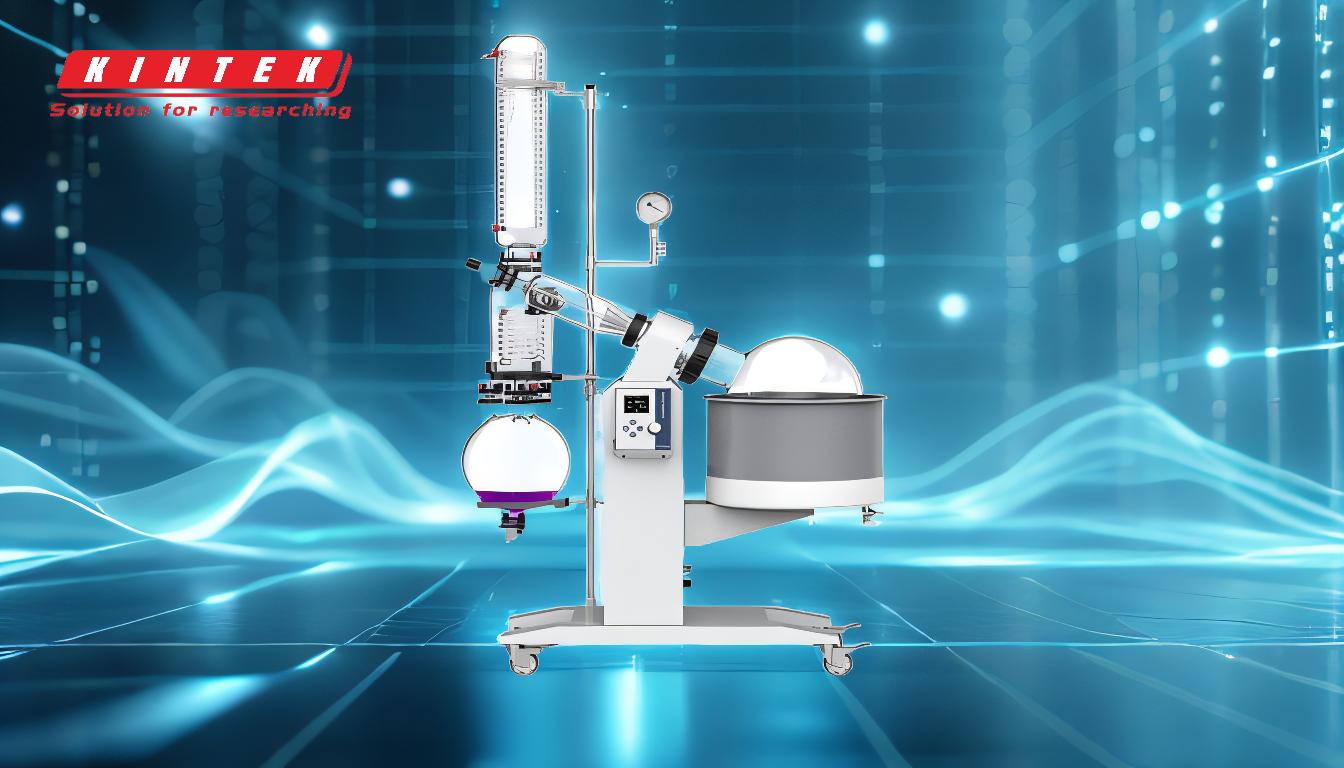Rotary evaporation is a widely used technique for removing solvents from samples by leveraging reduced pressure, controlled heating, and rotation to accelerate evaporation. The process involves creating a thin film of the solvent in a rotating flask, which increases the surface area for evaporation. A vacuum lowers the boiling point of the solvent, allowing it to evaporate at lower temperatures. The solvent vapors are then condensed and collected in a separate flask, leaving behind a concentrated sample. This method is efficient, gentle, and suitable for heat-sensitive compounds.
Key Points Explained:

-
Thin Film Formation Through Rotation
- The flask containing the solvent and sample is rotated at a controlled speed (typically 150-200 rpm).
- Rotation spreads the solvent as a thin film across the interior walls of the flask, significantly increasing the surface area exposed to heat and vacuum.
- This enhanced surface area accelerates the evaporation process, making it more efficient than static evaporation methods.
-
Reduced Pressure (Vacuum)
- A vacuum pump is used to lower the pressure inside the system.
- Lowering the pressure reduces the boiling point of the solvent, enabling it to evaporate at temperatures much lower than its standard boiling point.
- This is particularly beneficial for heat-sensitive samples, as it minimizes the risk of thermal degradation.
-
Controlled Heating
- The rotating flask is immersed in a heated water bath, typically maintained at 30-40°C.
- The heat provides the energy needed for the solvent to transition from a liquid to a vapor state.
- The temperature is carefully controlled to ensure efficient evaporation without overheating the sample.
-
Condensation and Collection
- The solvent vapors travel from the rotating flask into a condenser, which is cooled to a low temperature (often between -10°C and 0°C).
- The condenser causes the solvent vapors to re-condense into a liquid, which is then collected in a separate distillate flask.
- This step ensures that the solvent is effectively separated from the sample and can be recovered or disposed of as needed.
-
Advantages of Rotary Evaporation
- Efficiency: The combination of rotation, heat, and vacuum significantly speeds up the evaporation process.
- Gentleness: The lower boiling points achieved under vacuum reduce the risk of damaging heat-sensitive compounds.
- Scalability: Rotary evaporators are available in various sizes, making them suitable for both small-scale laboratory work and larger industrial applications.
-
Applications
- Commonly used in chemistry, pharmaceuticals, and food science for concentrating samples, purifying compounds, and removing solvents.
- Ideal for processing heat-sensitive materials, such as natural extracts, polymers, and biological samples.
-
Key Parameters to Optimize
- Rotation Speed: Adjusting the speed ensures an even thin film formation without splashing.
- Bath Temperature: Must be high enough to promote evaporation but low enough to avoid sample degradation.
- Vacuum Pressure: Fine-tuning the vacuum level ensures optimal boiling point reduction.
- Condenser Temperature: Proper cooling ensures efficient condensation of solvent vapors.
By understanding these key points, a purchaser of rotary evaporation equipment can make informed decisions about the specifications and features needed for their specific applications. Factors such as flask size, vacuum pump capacity, and temperature control precision should be carefully evaluated to ensure the equipment meets the desired performance and safety standards.
Summary Table:
| Key Aspect | Details |
|---|---|
| Thin Film Formation | Rotation (150-200 rpm) creates a thin film, increasing surface area. |
| Reduced Pressure | Vacuum lowers solvent boiling point, enabling low-temperature evaporation. |
| Controlled Heating | Water bath (30-40°C) provides energy for evaporation without overheating. |
| Condensation | Vapors are cooled (-10°C to 0°C) and collected in a separate flask. |
| Advantages | Efficient, gentle on heat-sensitive compounds, and scalable. |
| Applications | Chemistry, pharmaceuticals, food science, and heat-sensitive materials. |
| Key Parameters | Rotation speed, bath temperature, vacuum pressure, and condenser cooling. |
Ready to optimize your solvent removal process? Contact us today to find the perfect rotary evaporator for your lab!










